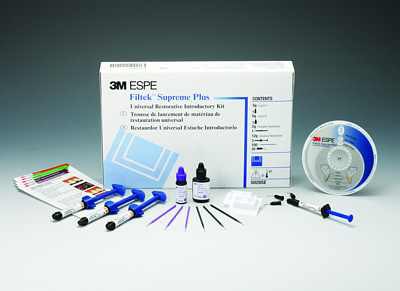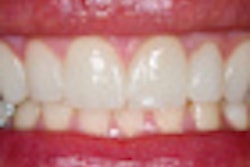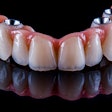
The 16-year-old came to Gordon Christensen in tears. Her enamel hypoplasia was so bad she couldn't attend her junior prom. Her parents were also distraught, but for a different reason: The cost of 28 veneers for their daughter was $30,000. Since the father’s annual income was $48,000, that level of treatment was out of the question. But in just 40 minutes, Dr. Christensen treated the teenager and sent her on her way, ready for the big night. His solution: Six resin-based ceramic veneers artfully placed just on her front teeth.
Veneers comprised fully one-third of the $8 billion worth of laboratory units produced in 2007, Gordon Christensen D.D.S., M.S.,Ph.D. told a packed audience at the recent 143rd Midwinter Meeting of the Chicago Dental Society. Yet, he added, "At least a third to a half [of all veneers] should never been done." Veneers are in greater demand than ever before, but it pays to know when they are really needed. In a detailed three-hour session, the well-known dentist, lecturer, and publisher (Clinicians Report, AKA, CRA Newsletter) surveyed the available types of veneers as well as options for cements, tools, and prep techniques. Dr. Christensen's product recommendations were seconded by many of the dentists and technicians in attendance.
Veneer Material
Before you get started, says Dr. Christensen, pick your materials. There are four options when it comes to veneers: Ceramic (fixed or pressed) and polymer (direct and indirect). Direct polymer goes to the head of Dr. Christensen’s class because it can be made to match the color of adjacent teeth and it bonds well to new resin. Indirect polymer wears the dunce cap in Dr. Christensen's classroom, along with a sign around its neck reading: "I’m no more than chemically dead resin." Adds the good doctor: "Trying to bond indirect polymer to new resin is asking quite a bit."
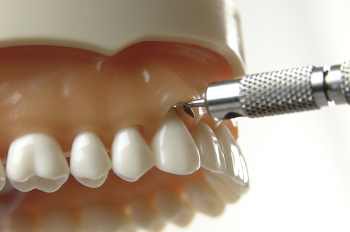 |
| Zekrya's Gingival Protector is Christensen's favorite for veneer prep. |
Preparation
Dr. Christensen then got down to the nitty-gritty of preparing teeth for veneers, focusing on three general approaches: no or slight prep; conventional prep in enamel; and deep prep, mostly in dentin. Dr. Christensen's big on the no prep option, pointing out that it's been a proven technique over the many years. He summarily ruled out the deep prep in dentin option. When deep bonds are called for in dentin, says Dr. Christensen, crowns are preferable to veneers. "The bond to dentin is inferior to the bond to enamel, despite what you read in some studies. The bond is good until you've had a thousand cups of coffee and a bunch of ice cream, and then the veneers fall off." His preference: Conventional prep in enamel, which works especially well with malformed teeth: "If you do them correctly, you can't get them off."
Resin-based composites
Dr. Christensen devoted at least an hour to a detailed examination of resin-based composites, with an emphasis on keeping dentists from being misled by vendor claims. The various fills can be used on both direct veneers, which bond better and make economic sense in situations where only a small number of teeth need work, and indirect veneers, which he doesn't favor due to bonding problems. But he's not swayed by promises of superior strength or smoothness made about microhybrid composites such as 3M/ESPE's Filtek Z250. He finds that they frequently turn rough after six months of brushing. The culprit: The relatively large particles (400 to 600 nanometers) of glass that are found in microhybrids and that inevitably produce roughness in a matter of months in either an indirect or direct veneer application.
'If you do them correctly, you can't get them off."
His take on the "old" microfilled posterior composite Heliomar A2? "It's weak and I don't like it."
Don't be misled by "nanohybrids" either, says Dr. Christensen. It’s simply another name for microhybrids, but with none of the constituents of the preferred nanofills. Flowable microhybrids, microfills, and nanofills might be suitable for addressing "nicks and cracks in an older person's teeth" but they don’t last long enough for a middle-aged patient.
Dr. Christensen sang the praises of two options for the external layer of a veneer: microfilled anterior composites (Durafill, Renamel, or Venus); and Filtek Supreme Plus, the single nanofill option currently available. He gave the anterior microfills credit for looking good for years: "They stay smooth and get smoother as you brush them." But what these silicon dioxide-based anterior microfills gain in smoothness, they lose in strength. For Dr. Christensen, nanofill is the option of choice. Why the high praise? Filtek Supreme Plus is comprised of tiny, 20-75 nanometer zirconium oxide balls that produce both exceptional smoothness and a strong bond. Nanofills also provide four levels of opacity -- dentin, body, enamel, and silox -- with body being the most popular.
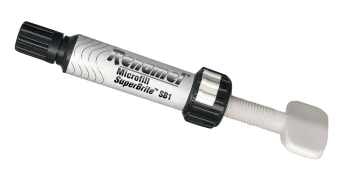 |
| Another fave: Renamel, a microfilled posterior composite. |
But not everyone should take this route, especially if you’re treating a woman in her forties who doesn't care much about smoothness. A patient will often choose a bright white veneer over one with more naturalistic stains. Remember, too, says Dr. Christensen, that ease of application makes resin-based composites ideal. For example, an 82-year-old woman came to Dr. Christensen on a Wednesday, hoping to attend her daughter's wedding reception the following Saturday. First, he removed two teeth crowding her mouth, then applied Filtek Supreme Plus and some bleach to the remaining teeth. That was all it took to send her off to the big event with a beautiful smile on her face. This minimal approach made sense in terms of time and work required. With older patients, says Christiansen, a few judiciously placed veneers make more sense than working on every tooth.
The no-prep way
Thin, no prep veneers aren't for everyone, says Dr. Christensen, but they are excellent options for patients with small teeth, anterior teeth with diastemas, or teeth in lingual version.
No-prep thin veneers are also a good pick when patients want fuller or longer teeth. But no-preps should come with a warning label, says Christiansen. Not only can you end up with some nasty cuts on your fingers when you apply them (because they're so thin), but they can break unless you handle them with extreme care. Another downside is the potential for lower contour. Still, the results can be dazzling. As an example, Dr. Christensen showed photos of a young Asian woman who wanted to lengthen her teeth. Thin veneers were perfect because her teeth were already in good condition. Dr. Christensen did periodontal recontouring and used a chlorhexadine rinse, as well as the thin veneers, to achieve the desired effect.
Dr. Christensen estimates he has applied 4000 veneers and replaced very few. "Thin veneers are an excellent choice because they last so long -- that is, as long as you use resin cement."
Tools and accessories
It’s essential to choose the right tool for the task, and much of Dr. Christensen’s session focused on tools that help dentists apply veneers properly and efficiently. His recommendations:
- Resin-curing lights: He favors plasma arc curing lights with a wider tip, which speeds the curing of large veneers.
- Articulating media: Most products are too thick, says Christiansen. But two products that pass the test are Madame Butterfly Silk from Almore International and AccuFilm II by Parkell.
- Polishing material: Diashine from VH Technologies.
- Bonding agent for big composites: Add&Bond by Parkell.
- Gingival protection when applying veneer preparations: Zekrya Gingival Protector, from Clinician's Choice.
- Trimming and finishing: GC New Metal Strips, from GC America.

Still another Gordon fave: Filtek Supreme Plus, the only single nanofill option available. Veneer Repair
Even if you use all the proper materials and apply them properly, you can still run into situations where veneers need repairing. Christensen gave the example of a girl who fell and broke her nose -- as well as a veneer. "Boy, we were heavily into dentin," he says. He sent the girl home after applying a provisional restoration with Durafill. He knew a crown wouldn’t work because he would never be able to match the color of adjacent teeth.
When she returned for a veneer, he used a one-quarter-round bur to make lateral holes in the dentin. Such "potholes," he emphasizes, are essential to improving the bond if the surface is all dentin. He then acid etched only the enamel portion as the dentin would be sensitive. Next, he applied a self-etching primer and washed it off quickly so it wouldn’t land on other teeth. After the primer stood for just 15 seconds, he put the bond on the veneer and the tooth, put the cement on the veneer, and seated the veneer. Veneers that come off in one piece can be reattached using the same sequence: Drilling lateral potholes, etching with hydrofluoric acid, and then applying the cement.
Christensen’s bottom lines: Ceramic veneers now comprise about one-third of U.S. dental laboratory production. Properly placed ceramic veneers can last many years, even longer than ceramic crowns. Fees charged for veneers should be as highor higher than crowns. Preparation work on dentin is to be avoided; however, non-prep veneers are a viable alternative for many patients.
